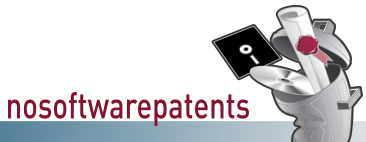| English | Deutsch |

![- Logo]](../images/layout007-small.png)
| Home |
| Software Patent of the year 2006 |
| About |
| Supporters |
| Background |
| News |
| Press November |
| Links |
| Contact |
| Imprint |
August – Patent 2
- EU-Patent on software (algorithm)
- Application to European Patent Office on 14/09/1999 by Lucent Technologies Inc. (USA)
- Granted on 28/04/2004
- Date of priority: 22/09/1998 (valid no more than until 22/09/2018)
- Patent attorney: legal department of the corporation
- Patent specification provided by FFII/Gauss
- Patent specification provided by EPO/espacenet
- Prize: Top 5 Killer Patent 2004 of the magazine Technology Review published by Massachusetts Institute of Technology (MIT) (the prize refers to the US-patent US6529499 which does not exhibit noteworthy differences to the EU-equivalent EP0999674)
- The decisive element are the claims, as they specify which actions are forbidden within the framework of the patent.
- Violating one single claim is sufficient to be considered a patent violation. Generally, claim number 1 is the decisive main claim which covers all other claims relating to special cases.
- The description is intended to help the reader interpret the claim. At the same time, it is supposed to document and disclose the details of the invention. This disclosure is the original purpose of the entire patent system.
- In practice, a patent specification contains no detailed information on how the patented procedure could be implemented (even if the patent owner allowed the implementation). In particular, a software patent contains no program code (reference implementation), but merely describes the idea of a software.
Patented idea: Permitting the build-up for time-critical connections, especially for telephone calls, only if there is available enough bandwidth
Main claim: In a gateway capable of giving priority to time-critical connections versus not time-critical connections the build-up of time-critical connections is denied, if the bandwidth is not sufficient
Further claims:
- Build-up of connection by the sender
- Permitting the build-up for time-critical connections, if there is enough bandwidth
- Monitoring the effective bandwidth and curtailing the sender’s bandwidth if necessary
- Implementing the mentioned methods within a VPN for the purpose of voice over IP
- Using the same servers for voice over IP and VPN
- Several VPN (e.g. one for each participant)
- Applying the mentioned methods with voice over IP in order to guarantee that delays and/or instabilities do not exceed given thresholds
- Using network-switches and various standards (STM, MPLS, dynamic routing, OSPF)
- Several servers for several administrative areas
- Allocating bandwidth also for data which is not time-critical
Description: The patent specification documents the idea that the claimed algorithms are important for internet telephone services (voice over IP)
Everyday parallel: In traditional (analogue) telephony every line has the capacity for exactly one telephone call. If the telephone switch (gateway) detects that the required participant is telephoning yet (bandwidth not sufficient), the build-up of a further connection is rejected and the caller receives a "busy"-signal.
Examples for patent infringements: Internet telephone services (voice over IP) and related software
| Previous Software Patents of the Month |
| > September |
| > August |
| Patent 1 | |
| Patent 2 | |
| Patent 3 | |
| Patent 4 | |
| Patent 5 |
| > July |
| > June |
| > May |
| > April |
| > March |
| Press Archive |
| > Oktober |
| > September |
| > August |
| > July |
| > June |
| > May |
| > April |
| > March |
